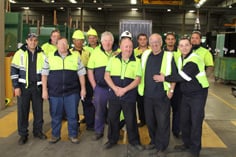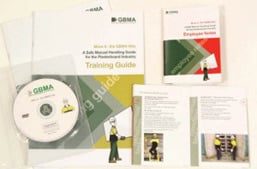
Last week, we looked at three different arguments to convince senior management about why they need to care about safety.
 For some companies, toolbox meetings can be a real drag with disinterested staff and the safety manager trying desperately to motivate staff and change behaviour.
For some companies, toolbox meetings can be a real drag with disinterested staff and the safety manager trying desperately to motivate staff and change behaviour.
In "The New Science of Building Great Teams" by Alex "Sandy" Pentland printed in Harvard Business Review, April 2012, new research has found that there are three factors that contribute to a great team - energy (how team members contribute to a team as a whole), engagement (how team members communicate with one another) and exploration (involves communication that members engage in outside their team).
The interesting thing about this research is that it quite neatly fits into some research undertaken in the field of positive psychology. In the book, Positivity, by Barbara Fredrickson, her extensive research found that positive people and workplaces have many benefits such as broadening the mind, doing what's right for others, improving physical health and building connections with others.
To improve your tool box talks, so that people are working together, you need to focus on making the meetings more positive. By doing this you will increase the energy, engagement and exploration. Let's take a look at how you transform your safety meetings.
1. Explain the new positive approach - Let everyone know that from now on, safety tool box meetings are going to be different. That you're all going to start being positive about safety, as by being positive you will all greatly improve your safety record and enjoyment of work. As the leader of the group, you want to make this approach sounds fun and inclusive. Keep people in check who are distrustful or fearful of the new positive approach. Ensure that you notice when something is being left unsaid or someone cannot get their say and encourages people to speak or cover issues that are being ignored.
2. Focus on 3 positives to 1 negative comment - In the book, Positivity by Barbara Frederickson, her research found that to lift morale of your workforce, an easy method is to focus on three positive comments for every one negative comment (in fact, for high performance teams the ratio is 6 to 1, but if you'e got real morale issues, working towards three positives is a good starting place). Let people know that they are expected to raise three positive comments about how safety is going with only one negative.
3. Focus on what is best for the company or group rather than people overly focusing on themselves. As the leader, you need to let people know that they need to act in the best interests of the group. if you realise that someone has brought up an issue that is for their own personal agenda, then you need to clarify this and get them to work on a group solution. If group members criticise someone or the company get them to open with "I might suggest..." rather than criticizing. Encourage people to ask questions when they do not understand issues or someone's point of view (rather than resorting to negative comments).
4. Start with Gratitude - This is going to be difficult one for some, but being grateful is an extremely powerful way to make people feel happy and comfortable with one another. Start your meeting with your staff thinking about positive things. This enables them to bring more ideas and workable solutions to any problems discussed in meetings.
In fact, in a regular business meeting that I attend chaired by Neville Christie, he used that process to get us all working together. Interestingly, our group had been together for many years before Neville started chairing, but the results have been startling. We're very much a high performance team collaborating and sharing issues. And we enjoy being with each other much more than before we started being grateful.
5. Tell stories to reaffirm correct safety behaviour - Once you've started these meetings, as the leader you need to give examples of the types of behaviour that you want to see repeated. Become a story finder and look out for examples during your week.
6. Announcing Safety Rewards - When it comes to enhancing performance and motivating staff - the best reward is positive feedback. It might seem a bit "twee", but we all like to hear we are doing a good job. And we're not likely to cheat or exhibit unethical behaviour, just to hear our boss give us a good rap. Make sure the feedback explains why the behaviour was good. You could also reward people with certificates. Just avoid giving money or presents.
Summing it Up
To get disengaged staff more engaged in toolbox talks, you can really improve the energy levels by making the meetings more positive. By introducing things to be thankful for at the start of the meeting and ensuring that your meetings have at a minimum three positive comments to one negative, you will really start to change the dynamics of the meetings. As the leader, chair the meetings so that everyone has a chance to give feedback and that all participants feel safe to talk. It will change things in a way you thought were not possible.
If you think these skills will help your team, learn how to put them into action in our Supervisor Leadership Skills for a Safe Workplace course.

Last week, we looked at three different arguments to convince senior management about why they need to care about safety.
